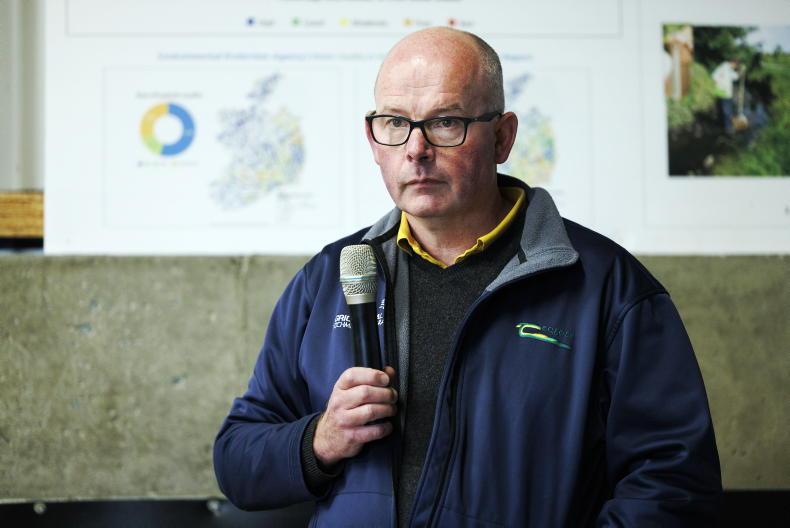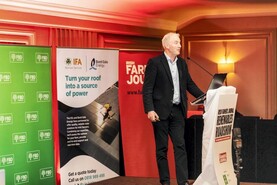This week, we saw two contrasting presentations in relation to water quality, farming and the relationship between the two.
One was from Eddie Burgess of Teagasc and the other was from Elaine McGoff of An Taisce.
The former was to farmers and people from agribusiness at the 2024 malting barley conference, the latter to the Oireachtas Committee on Agriculture.
Both presentations seemed to me to be trying to talk to farmers through those very different forums.
Nitrate conversation
Elaine McGoff highlighted that one piece of Teagasc research shows that slurry spreading, which gains such a high proportion of the conversation around nitrates, only accounts for 8% of all nitrate leached from farms.
Is this good news? Not really, as much as 63% - almost two-thirds - comes from cattle urine patches, with other 29%, almost one quarter, from applied chemical fertiliser.
McGoff went on to say she doesn’t consider housing cattle a fix-all solution; it will reduce nitrate leaching from cattle, but other negatives present themselves.
It becomes clear that grazing platform stocking intensity is becoming an area of focus for a reason. The more cows on a paddock, the more urine patches there will be and the more nitrates there are to leach.
But McGoff’s overall message to farmers was not one of adversity.
The only way to achieve that is with the support and involvement of farmers and communities
“We need to manage land in an integrated way, so that land use can meet multiple goals, while recognising the trade-offs and synergies between them, and balancing environmental, social and economic outcomes,” she said. “The only way to achieve that is with the support and involvement of farmers and communities.
“Farmers, more than anyone, need honesty. It’s their livelihoods on the line,” McGoff added. No-one can argue with that.
And this is where the Eddie Burgess's presentation was so fascinating. I’m not going to repeat it; you can read it here.
Essence
The essence of his presentation is that the message coming from water testing is a little more complex than the headline figures suggest.
While the profile of Ireland’s rivers didn’t improve visibly between 2018 and 2021, within that, there was some improvement within the sub-categories.
Good water status has two sub-categories - high and good - while poor water quality is subdivided into three categories - moderate, poor and bad.
Taking the Slaney as an example, Burgess said that of the 95 monitoring points along the river, 60 are high or good, the other 35 are moderate or poor and none are bad. Moreover, a number of monitoring points had moved from poor to moderate, which is progress and positive.
The challenge is to drill into those 95 separate stories to see what makes some better than others.
I reported on this story on Alan Poole’s farm previously. While not flowing into the Slaney itself, the water flowing through his dairy farm in Wexford is pristine.
Again, we need to look at what processes and management decisions contribute to this. Stocking rate might be a clear indicator of nitrates pressures, but it isn’t a simple slide-rule indicator of outcomes. Grazing-block stocking rate might be a better indicator than overall stocking rate.
Reaching out
I've previously said it would be great if anyone from An Taisce was to more directly engage with the work Teagasc is doing.
I know Elaine McGoff is extremely busy and water quality and the wider issue of how farming and the environment relate to each other is only part of what she does, but if she visited Johnstown Castle when they have their open days, she would see the vast amount of work that is being done in research, in farmer engagement and in application of research on farms.
That comes through adviser engagement through the ASSAP programme and the agricultural catchments program.
It puts another context on farming's evolving journey. We need to lose the "them and us" mentality - it is actually slowing progress.
We know that there are huge issues, ones we yet have no answer to, but we also know that research can potentially provide solutions. For instance, lowering protein in diets will reduce the intensity of those urine patches.
It's funny that there is so much optimism around solutions for the likes of electric cars in some quarters, but less for livestock farming. I made the plunge recently and, like Bob Dylan in 1965, went electric.
I drove my electric car to an ACRES training course last week. Typically, I left it to the last minute to do my course and ended up having to go to Dualla in Tipperary for a course run by Tim Bourke and PJ Phelan.
After the course, I had to head for Cashel - away from home - to recharge my battery. While it recharged, I reflected on what had been a fascinating day.
Differences
There were a few differences to a similar event in Wexford. I was the only tillage farmer in the room for starters and there was a lot of mentions of horses, something I've never heard at home.
But the most notable aspect of it was the mindset of farmers to the footprint of the food production on their land.
There was huge interest in tree planting, a long discussion on hedgerow planting, improvement and maintenance. Birdboxes and biodiversity were chatted about. A lot of this conversation was farmer-led.
We also visited a farm where cattle were being fattened with little meal and no fertiliser - lovely continental cows, yearlings and forward stores munching happily on red clover silage, which they obviously preferred to the grass silage beside it.
The farmer was not organic and not considering conversion yet, but, so far, his land was in rude health. Should people like him be allowed to import slurry, seeing as how chemical fertiliser is a bigger problem than slurry?
Farmers' minds are already open to the evolution of food production. But, as Elaine McGoff pointed out, it's their livelihoods on the line.
And we thus come to the same conclusion we always seem to come to, no matter the starting point - farmgate prices will have to increase to something close to 2022 levels to allow farmers to reduce the intensity of their systems and remain economically viable.
The sooner we all agree on that, the quicker the rest might fall into place.






 This is a subscriber-only article
This is a subscriber-only article










SHARING OPTIONS: